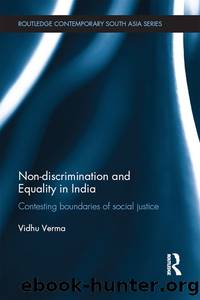Non-Discrimination and Equality in India: Contesting Boundaries of Social Justice by Vidhu Verma

Author:Vidhu Verma [Verma, Vidhu]
Language: eng
Format: epub
Tags: Ethnic Studies, Social Science, Political Science, Regional Studies, General
ISBN: 9781136515019
Google: MVDgCgAAQBAJ
Goodreads: 17544710
Publisher: Routledge
Published: 2011-11-17T00:00:00+00:00
Merit vs. institutional capacities
I argued above that the university, especially under the Nehruvian model, gradually developed as an elitist institution recruiting its faculty and students on the basis of some kind of proven merit. Generally acquisition of merit in educational institutions is equated with intelligence-plus-effort as its possessors are seen to have proven these qualities. Academic merit in technical institutes like IIT is the sole criterion for undergraduate admission. Based on the JEE the system ensures that individuals with the most developed quantitative, analytical and scientific skills enter the institution.
For implementing quotas, one of the routes for admission into select institutions has been different qualifying standards for general seats and reserved seats. The differences in minimum scores needed to qualify are guided by the objective of increasing admission of under-represented candidates. Those who belong to the reserved category are admitted only after they secure a minimum percentage, even though this is lower than the percentage for others. Sometimes quotas are defined at the outset so that the proportion of different targeted groups can be adequately represented. Such predetermined reservations of numbers of places for targeted groups are sometimes viewed as faulty; even if students from reserved categories qualify for general seats they will not be viewed as filling quota seats. The technique of âbandingâ â concealing the differences in performance by lumping ranges of scores together â is quite common. On the other hand, many of these seats go unfilled as there is an insufficient number of candidates of reasonable quality or of merit to fill these positions up, particularly as one goes up the ladder in terms of job content. When we look at the evidence about drop-out rates and illiteracy among lower castes at secondary and tertiary levels, it is not surprising that there might not be sufficient candidates, particularly amongst the SCs and STs, to fill the quotas.
It is for these reasons that arguments against reservations sometimes turn to improving the schooling provided at the primary and secondary level for these groups. Affirmative action in higher education admissions targets students who have completed their secondary education successfully. However politicization of educational selection has led to reliance on governmental largesse; energies of political leadership have been diverted towards getting their groups classified as OBC. Are these short-cut arguments? State policy after all should be geared towards lowering drop-out rates and illiteracy levels in general, to overcome the lack of resources mentioned above. In as much as lower-caste students drop out because they cannot afford to remain in the school system quotas have to be accompanied by scholarships and publicly funded high quality school education that provides access to all.
To have Rawlsian âfairâ equality of opportunity in society one must also understand the large philosophical issues that underpin the issues of merit and efficiency. The criteria for merit are fairly arbitrary and not always closely linked to the nature of the job. So the first task is to have a better system of assessing skill or ability apart from the present criteria.
Download
This site does not store any files on its server. We only index and link to content provided by other sites. Please contact the content providers to delete copyright contents if any and email us, we'll remove relevant links or contents immediately.
What's Done in Darkness by Kayla Perrin(25493)
Shot Through the Heart: DI Grace Fisher 2 by Isabelle Grey(18209)
Shot Through the Heart by Mercy Celeste(18153)
The Fifty Shades Trilogy & Grey by E L James(17768)
The 3rd Cycle of the Betrayed Series Collection: Extremely Controversial Historical Thrillers (Betrayed Series Boxed set) by McCray Carolyn(13182)
The Subtle Art of Not Giving a F*ck by Mark Manson(12898)
Scorched Earth by Nick Kyme(11823)
Stepbrother Stories 2 - 21 Taboo Story Collection (Brother Sister Stepbrother Stepsister Taboo Pseudo Incest Family Virgin Creampie Pregnant Forced Pregnancy Breeding) by Roxi Harding(11019)
Drei Generationen auf dem Jakobsweg by Stein Pia(10211)
Suna by Ziefle Pia(10179)
Scythe by Neal Shusterman(9251)
International Relations from the Global South; Worlds of Difference; First Edition by Arlene B. Tickner & Karen Smith(8600)
Successful Proposal Strategies for Small Businesses: Using Knowledge Management ot Win Govenment, Private Sector, and International Contracts 3rd Edition by Robert Frey(8407)
This is Going to Hurt by Adam Kay(7682)
Dirty Filthy Fix: A Fixed Trilogy Novella by Laurelin Paige(6445)
He Loves Me...KNOT by RC Boldt(5798)
How to Make Love to a Negro Without Getting Tired by Dany LaFerrière(5369)
Interdimensional Brothel by F4U(5299)
Thankful For Her by Alexa Riley(5149)
